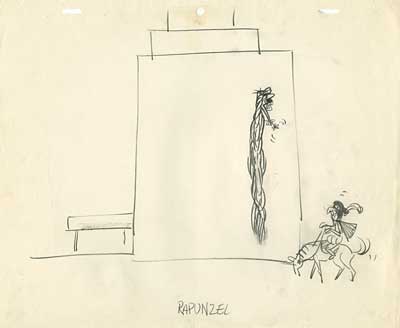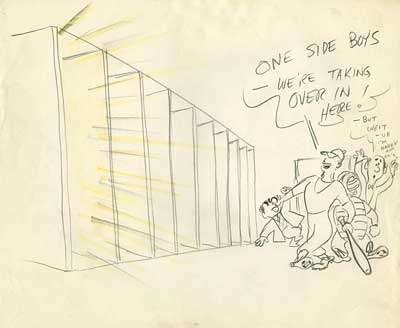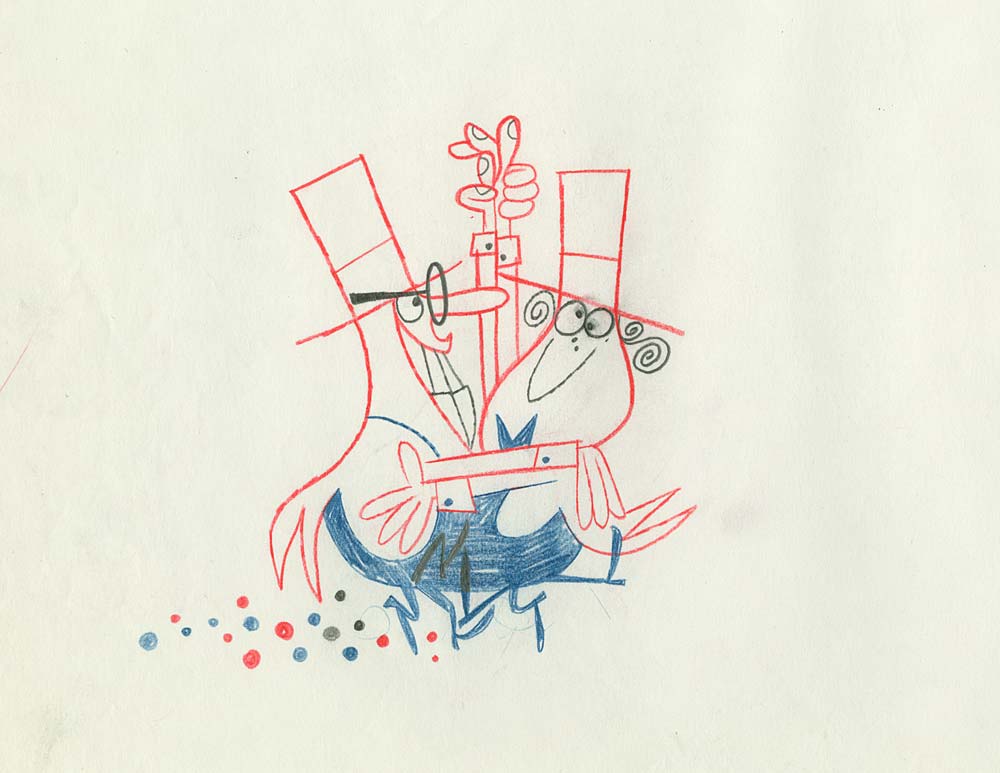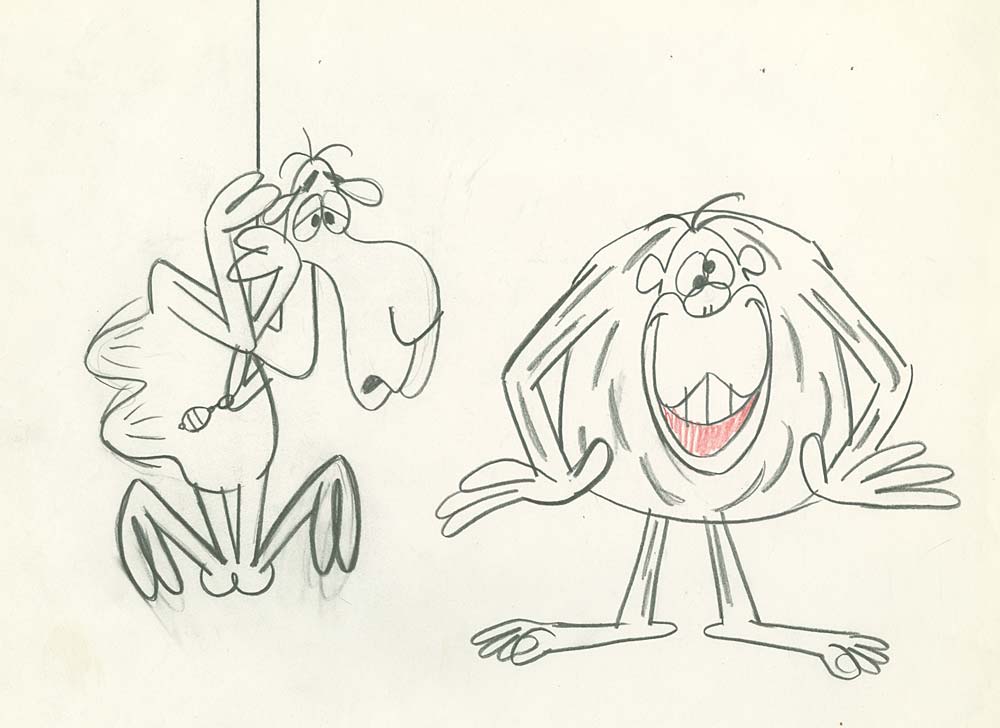People who aren’t members of Animation Resources don’t understand how comprehensive our Reference Packs are. Over the next couple of weeks, we will be posting what each section of our current RefPack looks like. If you are a member of Animation Resources, click on this post to go to the Members Only page. If you aren’t a member yet, today is the perfect time to join! Our current Reference Pack is one of our best yet, and General and Student Members get access to a special Bonus Archive with even more material from past Reference Packs.
What are you waiting for?

JOIN TODAY!
https://animationresources.org/membership/levels/
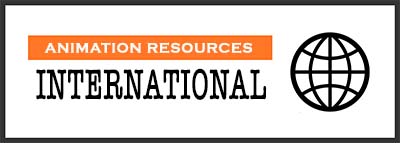
The world of animation is much bigger than it might appear to us at first glance. We are all familiar with the films we grew up with, but Hollywood wasn’t the only place that produced great cartoons… Poland, Japan, Russia, China and Europe all have their own traditions and a rich history of animated film making. Animation Resources’ archive contains many foreign films that are rarely seen in the United States. We feature a sampling of interesting animation from around the world in each Reference Pack.
MEMBERS LOGIN To Download
JOIN TODAY To Access Members Only Content
SD VIDEO:

Mr. Rossi At Camping

Bruno Bozzetto / Italy / 1970
Download this article
Bruno Bozzetto is an Italian animator known for his parody of Fantasia titled Allegro Non Troppo. His other feature films include a superhero parody called VIP My Brother Superman and a spaghetti western parody titled West And Soda. Bozzetto’s work is often satirical and political in nature, championing the common man and lampooning government inefficiency and oppression.

Bozzetto’s most famous character is Signor Rossi, an everyman figure he featured in many animated shorts and three feature films, Mr. Rossi Looks For Happiness, Mr. Rossi’s Dreams, and Mr. Rossi’s Vacation. In the short film we are sharing today, Mr. Rossi takes a camping trip and ends up dangling from a mountain crag.

Bozzetto’s work is not as well known in the United States as it should be, but it is recognized and appreciated across Europe. Recently, Animation Resources has been working to acquire more of his films for the Animation Archive, and we hope to share them with you in future Reference Packs. We think you’ll find a lot to inspire you in Bozzetto’s work.
REFPACK058: Mr Rossi At Camping 1970

MP4 Video File / SD / 6:50 / 129 MB Download
MEMBERS LOGIN To Download
JOIN TODAY To Access Members Only Content
SD VIDEO:

Two Czech Theatrical Commercials

Adi The Raccoon 1931 / Hannibal In Virgin Forest 1932
Animation Resources’ digital archive recently received a batch of early Czechoslovakian animated films. Among them were these two animated commercials. We tend to think of commercials as being primarily from the television era, but in the 1930s, a great deal of advertising animation was produced for theaters. These two shorts are interesting examples, and they illustrate how influential Disney and Fleischer cartoons were, even in Europe.
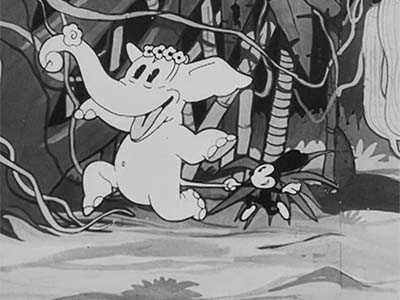
The history of animation in Czechoslovakia goes back to the 1920s. I believe the two films we are sharing with you here are by Karel Dodal, who not only produced advertisements (some featuring Felix the Cat), but also puppet and experimental films. The first advertisement, "Adi The Raccoon" looks very much like a contemporary American Mickey Mouse ripoff. The second one, "Hannibal In Virgin Forest" shows the influence of the Fleischer Betty Boop and Bouncing Ball cartoons. The notes that came with these films were sparse and all in the Czech language, so we don’t know much about them. If you have information you can share with us, please drop us a line.

REFPACK058: Adi The Raccoon 1931

MP4 Video File / SD / 03:54 / Silent / 59 MB Download
 REFPACK058: Hannibal In Virgin Forest 1932
REFPACK058: Hannibal In Virgin Forest 1932

MP4 Video File / SD / 04:30 / 62 MB Download
MEMBERS LOGIN To Download
JOIN TODAY To Access Members Only Content
SD VIDEO:

The Scayrecrow

Ashley Thorpe / UK / 2008
In our podcast "Different Artists, Different Paths", we suggested that independent animation should reflect the ideas of the artists who make it and not just imitate big studio products. The best independent films are completely different from what big studios produce— original ideas that follow no established formula. We pointed out that big studios have deep pockets, and there is no way to succeed if you try to compete on their playing field with expensive, labor intensive effects and full animation with lots of inbetweens and overlapping action. We talked about the importance of experimenting and exploiting technology to employ new techniques that haven’t been tried before. We mentioned how independents should build their audience by sharing smaller form content for free to generate interest that drives the financing and crowdfunding for larger projects. And last, but not least… we explained that independent animators need to be willing to invest "sweat equity" into their projects and find like-minded associates to team up with to make their films succeed. As an example, we shared Ashley Thorpe’s feature film, Borley Rectory. Today we share one of the experimental shorts he made leading up to his feature, "The Scayrecrow".

Although on the surface this film sometimes feels like a live action film, it is actually animation, composed and visualized from the ground up. As you watch it, you have to keep reminding yourself that none of this exists in reality. It’s convincing without being overly realistic. Visually, the film is gorgeous with artfully composed shots and effective cinematics. It’s efficient too, with cascading images to make up for low frame rates and animation and live action used for the things they each do best. The collage technique creates an effective mood to put the story across.

The genre of film making, the way the story is presented, and the techniques and tools used to make the film all work together to create an efficient animated film that follows no established model. The technique used to produce it is the epitome of "form following function" and the result is a film that is unlike anything you’ve ever seen before. "The Scayrecrow" is a brilliant example of "thinking outside the box" and if the art of animation is to progress, it needs to push the boundaries of what an animated film can be.
REFPACK058: The Scayrecrow 2008

MP4 Video File / SD / 12:26 / 156 MB Download
MEMBERS LOGIN To Download
JOIN TODAY To Access Members Only Content
SD VIDEO:

Chingo Muchabei Ep. 18 & 21

Daikichiro Kusube / TMS – A Production / Japan / 1971
For many years, Chingo Muchabei was believed to be lost. It had a very unlucky history. It was based on a manga drawn by Kenji Morita for Shonen Magazine in 1967. TMS picked it up for a 26 episode series in 1967, but because it was in black and white, the network kept delaying its debut in favor of color series. Eventually, in 1971 it ran alongside old re-runs as a contractual obligation for a couple of months and then disappeared completely. Three and a half decades later, the film elements were found in storage and the series ran on Japanese television again.
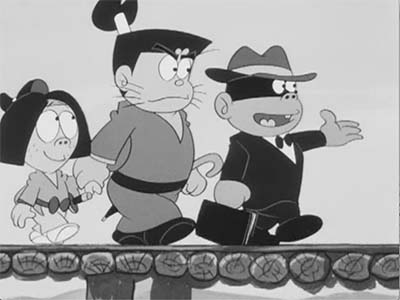
Chingo Muchabei is a slapstick comedy series based in 17th century Japan. The titular character is a freelance samurai who peddles umbrellas to support himself. The heir to the lordship of the province, Bokemaru is believed to be dead, but in fact he lives and Chingo Muchabei serves him. Lord Toyotomi discovers that the true heir to his province is alive and sends a bumbling ninja named Kaburezukin to kill him. But Chingo Muchabei foils him at every turn, using his umbrellas as weapons.
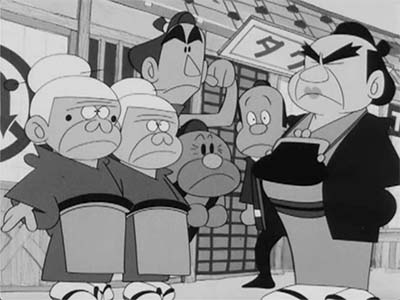
This series depends more on dialogue than other Japanese TV cartoons we’ve shared, so the stories are difficult to puzzle out. But the two episodes we are presenting this time involve Sumo Wrestling and a haunted house full of Yokai Monsters, which are themes that always seem to make for good subjects for cartoons. The historical time period isn’t adhered to completely. You’ll see modern ideas thrown in for the sake of gags, and the tone of the show is pretty goofy with lots of fun expressions.
We will bring you more early anime in upcoming Reference Packs.
REFPACK058: Chingo Muchabei Ep. 18

MP4 Video File / SD / 25:58 / 224 MB Download
REFPACK058: Chingo Muchabei Ep. 21

MP4 Video File / SD / 25:57 / 240 MB Download

Get your friends to join Animation Resources!

More members mean we can bring you more special downloads.
MEMBERS LOGIN To Download
JOIN TODAY To Access Members Only Content
THIS IS JUST THE TIP OF THE ICEBERG!
Animation Resources has been sharing treasures from the Animation Archive with its members for over a decade. Every other month, our members get access to a downloadable Reference Pack, full of information, inspiration and animation. The RefPacks consist of e-books jam packed with high resolution scans of great art, still framable animated films from around the world, documentaries, podcasts, seminars and MORE! The best part is that all of this material has been selected and curated by our Board of professionals to aid you in your self study. Our goal is to help you be a greater artist. Why wouldn’t you want to be a member of a group like that?
Membership comes in three levels. General Members get access to a bi-monthly Reference Pack as well as a Bonus RefPack from past offerings in the in-between months. We offer a discounted Student Membership for full time students and educators. And if you want to try out being a member, there is a Quarterly Membership that runs for three months.
JOIN TODAY!
https://animationresources.org/membership/levels/
FREE SAMPLES!
Not Convinced Yet? Check out this SAMPLE REFERENCE PACK! It will give you a taste of what Animation Resources members get to download every other month! That’s 560 pages of great high resolution images and nearly an hour of rare animation available to everyone to download for FREE! https://animationresources.org/join-us-sample-reference-pack/
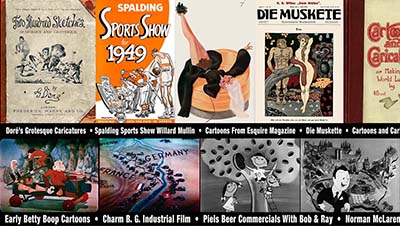

 Animation Resources depends on your contributions to support its projects. Even if you can’t afford to join our group right now, please click the button below to donate whatever you can afford using PayPal.
Animation Resources depends on your contributions to support its projects. Even if you can’t afford to join our group right now, please click the button below to donate whatever you can afford using PayPal.









 by
by 

![]()
![]()
![]() Animation Resources depends on your contributions to support its projects. Even if you can’t afford to join our group right now, please click the button below to donate whatever you can afford using PayPal.
Animation Resources depends on your contributions to support its projects. Even if you can’t afford to join our group right now, please click the button below to donate whatever you can afford using PayPal.
















